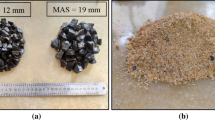Abstract
Effect of isobutyl-triethoxy-silane penetrative protective agent on the carbonation resistance of the concrete was studied. The concrete specimens for the 28 d accelerated carbonation process were manufactured with w/c of 0.49 and 0.64, both in the presence and absence of silane and mineral admixture. The penetration of isobutyl-triethoxy-silane and the carbonation of concrete were investigated by penetration depth, carbonation depth, XRD, SEM, and pore size distribution. The results showed that concrete compactness played an important role in the silane penetration and carbonation resistance. Penetration depth of silane-treated concrete mainly depended on the compactness of the concrete, and could not remarkably change through the accelerated carbonation process. In the accelerated carbonation process, penetrative protective agent improved the carbonation resistance of the higher compactness concretes but accelerated the carbonization process of the lower compactness concretes. As penetrative protective agent penetrated along the external connectivity pores into concrete not filling the entire surface area, the inorganic film could not fully protect the Ca(OH)2 phase from carbonation. After 28 d accelerated carbonation, fibrous hydration products disappeared and the surface holes decreased. Due to the formation of carbonized products, the porosity of the concrete surface decreased, especially in high-strength concrete.
Similar content being viewed by others
References
Mehta P K, Momteiro P J M. Concrete: Microstructure, Properties, and Materials[M]. USA: McGraw-Hill Professional, 2006
Carvajal A M, Jorquera C. Effect of Marine-Industrial Environment on Reinforced Concrete Structures with Superficial Protection of Acrylic-Incorporated Mortar[J]. Revista de la Construcción, 2010, 9(2): 108–115
Medeirosa M H F, Gobbia A, Réusa G C, et al. Reinforced Concrete in Marine Environment: Effect of Wetting and Drying Cycles, Height and Positioning in Relation to the Sea Shore[J]. Construction and Building Materials, 2013, 44: 452–457
Dai Jianguo, Akira Y, Wittmann F H, et al. Water Repellent Surface Impregnation for Extension of Service Life of Reinforced Concrete Structures in Marine Environments: the Role of Cracks[J]. Cement and Concrete Composites, 2010, 32(2): 101–109
Kargol M A, Müller U, Gardei A. Properties and Performance of Silane: Blended Cement Systems[J]. Materials and Structures, 2013, 46(9): 1 429–1 439
Arkles B. Tailoring Surfaces with Silanes[J]. Chemtech, 1977, 7(12): 766
Christodouloua C, Goodierb C I, Austinb S A, et al. Long-Term Performance of Surface Impregnation of Reinforced Concrete Structures with Silane[J]. Construction and Building Materials, 2013, 48: 708–716
Basheer P A M, Basheer L, Cleland D J, et al. Surface Treatments for Concrete: Assessmentmethods and Reported Performance[J]. Construction and Building Materials, 1997, 11(7): 413–429
Christodoulou C, Goodier C I, Austin S A, et al. Assessing the Long-Term Durability of Silanes on Reinforced Concrete Structures[C]. Proc of ICDC 2012 Congress, Trondheim, Norway, 2012
Breccolotti M, Bonfigli M F, Materazzi A L. Influence of Carbonation Depth on Concrete Strength Evaluation Carried out Using the SonReb Method[J]. Ndt. & E. International, 2013, 59: 96–104
Andersson R, Fridh K, Stripple H, et al. Calculating CO2 Uptake for Existing Concrete Structures during and after Service Life[J]. Environmental Science & Technology, 2013, 47(20): 11 625–11 633
Yang Ping, Li Weihua, Zhao Tiejun. Protective Effect of Surface Coating on Concrete[J]. Journal of The Chinese Ceramic Society, 2012 40(11): 1 613–1 617
Vries D J, Polder R B, Borsje H. Durability of Hydrophobic Treatment of Concrete[C]. Proc of the Second International Conference on Concrete under Severe Conditions, CONSEC, 1998, 98: 1 341–1 350
Attanayaka U, Ng S, Aktan H. Criteria and Benefits of Penetrating Sealants for Concrete Bridge Decks[R]. Michigan:Michigan Department of Transportation, 2002
Schueremans L, Van Gemert D, Giessler S. Chloride Penetration in RC-Structures in Marine Environment–Long Term Assessment of A Preventive Hydrophobic Treatment[J]. Construction and Building Materials, 2007, 21(6): 1 238–1 249
Barbara P, Andreas L, Elisa F, et al. Ethyl Silicate for Surface Treatment of Concrete-Part II: Characteristics and Performance[J]. Cement and Concrete Composites, 2012, 34(2): 313–321
Zheng Haibing, Li Weihua, Ma Fubin, et al. The Effect of a Surface-Applied Corrosion Inhibitor on the Durability Of Concrete[J]. Construction and Building Materials, 2012, 37: 36–40
Duan P, Shui Z, Chen W, et al. Effects of Metakaolin, Silica Fume and Slag on Pore Structure, Interfacial Transition Zone and Compressive Strength of Concrete[J]. Construction and Building Materials, 2013, 44: 1–6
Ngala V T, Page C L. Effect of Carbonation on Pore Structure and Diffusional Properties of Hydrated Cement Pastes[J]. Cement and Concrete Research, 1997, 27(7): 995–1 007
Monteiro I, Branco F A, Brito J, et al. Statistical Analysis of the Carbonation Coefficient in Open Air Concrete Structures[J]. Construction and Building Materials, 2012, 29: 263–269
Tuutti K. Corrosion of Steel in Concrete[R].Swedish Cement and Concrete Research Institute, Stockholm, 1982
Author information
Authors and Affiliations
Corresponding author
Additional information
Funded by the National Sci-Tech Support Plan of China (No. 2013BAJ10B05) and Marine Interdisciplinary Research Guide Fund of Zhejiang University (No. 2012HY003B)
Rights and permissions
About this article
Cite this article
Xu, Q., Zhan, S., Xu, B. et al. Effect of isobutyl-triethoxy-silane penetrative protective agent on the carbonation resistance of concrete. J. Wuhan Univ. Technol.-Mat. Sci. Edit. 31, 139–145 (2016). https://doi.org/10.1007/s11595-016-1343-6
Received:
Accepted:
Published:
Issue Date:
DOI: https://doi.org/10.1007/s11595-016-1343-6




